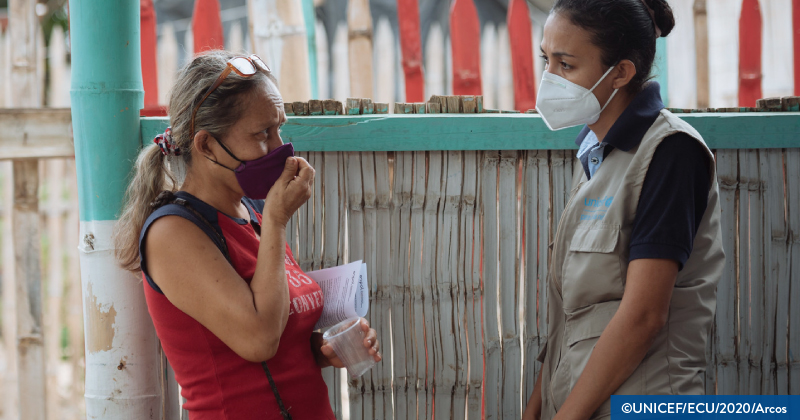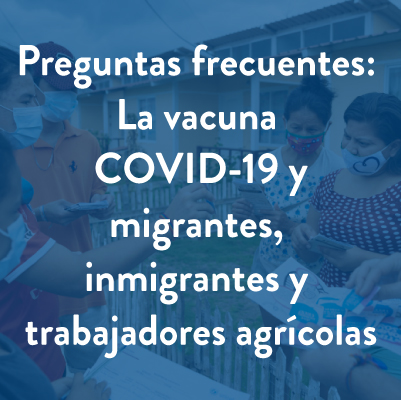- Who We Are
- Clinician Employment
- Publications
- Witness to Witness (W2W)
- El Premio Kugel & Zuroweste a la Justicia en la Salud
- Your Voice Matters: Photovoice Project
Wed, 11/10/2021 | by MCN Administration


[Editor’s Note: On October 21, 2021, Migrant Clinicians Network (MCN) hosted a webinar, ‘Lessons from the Field: Vaccinating Our Immigrant and Migrant Communities', which was supported by funding from the CDC through the National Resource Center for Refugees, Immigrants, and Migrants (NRC-RIM). Experts from across the US shared their experiences working to vaccinate vulnerable communities. Presenters included Eva Gálvez, MD, a member of MCN's Board of Directors and former Board Chair, Nadya Julien, CRNP, and Caroline Johnson, FNP-BC, MCN’s inaugural recipient of MCN’s Kugel and Zuroweste Award. Syreeta Wilkins, NRC-RIM's Communications Strategist shared resources created by NRC-RIM, as well as resources created through NRC-RIM and MCN’s partnership, which are linked below.]
“I am passionate because I know what COVID is,” shares Nadya Julien, CRNP. Like many across the globe, Julien has felt the brutal impact of COVID-19. Falling ill with the virus last year, Julien spent two weeks at a local hospital and lost her mother to COVID-19 shortly after. As the CEO, founder, and practitioner at Tabitha Medical Care, a Delaware-based primary care clinic, Julien has used her heart-wrenching experiences, medical expertise, and unique position of trust, to change the outcome of the pandemic for marginalized Haitian, Latinx, and Black communities. “It comes from my heart, it comes from a personal level,” she says while describing what inspires her to educate her community.
Getting personal with communities by relating experiences of COVID-19’s impact has been a powerfully effective strategy for one-on-one conversations held within clinics and community spaces. Eva Gálvez, MD, a family physician who serves immigrant and migrant families, agricultural workers, and factory workers at Virginia Garcia Memorial Health Center in Oregon, has successfully encouraged patients to get vaccinated using this same technique. For patients who are fearful of affected fertility from COVID-19 vaccines, Dr. Gálvez shares real stories of peers and community members who have gotten pregnant and had healthy babies after being vaccinated. She explains that a productive tactic has been to steer data-focused conversations towards ones that are “really personal”, community-based, and depict the potential repercussions of not getting vaccinated.
Case studies demonstrate these conversations are best executed from strong foundations of trust between health care workers and their communities. Pre-pandemic trust has been a key factor in the success of Dr. Gálvez’s clinic. Utilizing clinicians who are from the same culture and speak the same language as patients has also increased levels of trust. Recounting previous incidents, Dr. Gálvez explains that many patients have expressed that their trust for, and familiarity with, clinicians at her clinic have been their reasons for attending clinic vaccination events. Julien, hearing similar patient testimonies, recalls patients telling her that if her clinic offered the vaccine, and she tells them the vaccine is safe, they would get vaccinated.
Keeping this relationship of trust is critical. “You have to always be honest,” explains Julien. “Vaccine hesitance does not equal being an anti-vaxxer.” Julien spends ample time at the start of vaccine appointments explaining potential side effects, so patient’s experiences aren’t misinterpreted as vaccine-induced illness. This prevents the spread of myths throughout the community. Caroline Johnson, FNP-BC, clinical director of Proteus, Inc, an Iowa clinic serving seasonal and resident farmworkers, stresses the importance of communicating with patients that providers are learning as they go, and are basing their recommendations on their current knowledge of science. She encourages clinicians to validate patient’s fears; “I think it is important to be transparent,” she explains. Wanting to promote patients’ “autonomy and ability to choose” has been the foundation of her process of validating concerns, hearing, and then responding. Dr. Gálvez notes that humbly explaining to patients the reasons for changing vaccine recommendations, specifically that recommendations are coming out of caution, with safety being the priority, is key.
Actively creating spaces for conversations is critical for increasing vaccination rates. Julien, noting the particularly strong vaccine reluctance in the Haitian community, explains that intentionally asking for patient’s unanswered questions while doing extensive one-on-one education is necessary. For reserved and uninterested Spanish-speaking farmworker communities, one-on-one conversations “really do work,” explains Dr. Gálvez, as not everyone can be reached through social media campaigns. Johnson explains, “Sometimes you have to close your computer and give your patients your full attention.” While health care providers are often limited to just a few face-to-face minutes, Johnson has found that conversations are more effective without technology getting in the way and the technique has led to “really powerful” and successful conversations.
Yet not all encounters need to, or should be, solely between a patient and their provider. “I think providers have a really important role of finding other trusted messengers like pastors and teachers, and arming them with that information about vaccines,” explains Dr. Gálvez. Faith-based partners have been key in much of Julien’s work, especially for the Latinx community. “When you go, you do not just go to vaccinate, you go to be part of the Church service,” she explains. For Johnson, employers have been crucial. Working with employers to disseminate COVID-19 vaccine education videos on employee-focused web pages has been an avenue to reach employees before they arrive at farms.
One-on-one conversations with parents, the new focus of many vaccination efforts, have been especially important, and perhaps not as difficult as one might expect. Dr. Gálvez, having witnessed countless conversions of concerned parents, from being unsure about vaccinating their children, to signing waivers, notes that just being able to speak with a provider seems to “really lay those concerns [to] rest.” However, clashes between teens and their parents have proven to be more difficult dynamics to maneuver. In cases where teens can speak and read English, and their parents cannot, Dr. Gálvez has seen teens baffle their parents through their explanation of incorrect “expert” content from social media. “The parents almost feel like they have been defeated,” she explains. With a large young patient population in her community, Dr. Gálvez has seen youth become some of the more hesitant populations she serves. While Facebook and Zoom have been important channels to reach older populations, these platforms are not frequented by younger generations. She advises that new innovative ways to reach youth be used, on the social media platforms that they use.
Resources:
- 10/21/2021 – Webinar - Lessons from the Field: Vaccinating Our Immigrant and Migrant Communities - YouTube
- Customizable COVID-19 resources in different languages: National Resource Center for Refugees, Immigrants, and Migrants (NRC-RIM)
- Customizable ‘Get Vaccinated’ Campaign (NRC-RIM)
- Customizable ‘Get the Facts’ Campaign (NRC-RIM)
- MCN blog: Pregnant? Get Vaccinated Immediately, Says the CDC with New Data in Hand
- MCN Pregnancy and COVID-19 Editable Trifold: English, Spanish
- MCN blog: Include the Alias? Skip the Real Name? COVID-19 Vaccination Card Recommendations
- Conversation Guide: Fertility + Parenthood
- MCN’s Fully Editable “Vaccination Is” Campaign
- Makespace: IDEO.org Campaign Development Tool (NRC-RIM)
Got some good news to share? Contact us on our social media pages above.
Return to the main blog page or sign up for blog updates here.







